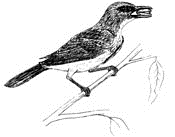Vertebrate Pest Conference: Proceedings

Vertebrate Pest Conference Proceedings: 17th (1996)
Date of this Version
1996
Document Type
Article
Citation
Published in Proceedings: Seventeenth Vertebrate Pest Conference … 1996, ed. Robert M. Timm & A. Charles Crabb (University of California, Davis, 1996).
Abstract
The palatability of 12 rodenticide baits, formulated to vary from poorly accepted to well accepted, was measured in laboratory choice tests against Wistar and wild-caught Norway rats. The baits, derived from six bait bases and two active ingredients, difenacoum and bromadiolone, were simultaneously tested in the field against 24 farm infestations (2/formulation) in order to investigate the relationship between palatability and efficacy. Bait acceptance in laboratory tests, with EPA meal as the challenge diet, varied from 7.0 to 50.6% for Wistar rats and 3.7 to 85.1 % for wild rats. Changing the challenge diet to a ground-up laboratory animal food significantly increased the apparent palatability of three selected baits to Wistar rats, although the relative pay abilities between the formulations remained the same. Bait acceptance, as measured in the laboratory, was unrelated to the degree of control achieved in farm treatments. The presence or absence of alternative food and whether the baits were placed in containers or applied directly into rat burrows appeared more likely to determine the outcome and overwhelmed any influence due to bait palatability. The combined effect of container- and burrow-baiting reduced the rat populations by an average 96.8% with 16 of the 24 populations tested completely eradicated. The least palatable baits dispensed into burrow entrances controlled rats on all farms, including those with abundant food sources.
Included in
Animal Sciences Commons, Bioresource and Agricultural Engineering Commons, Environmental Engineering Commons


Comments
Copyright © 1996 (where applicable) by the Vertebrate Pest Council of the Vertebrate Pest Conference. Used by permission.